A Parametric Design Method for the Lighting Environment of a Library Building Based on Building Performance Evaluation
Abstract
1. Introduction
2. Literature Review
3. Research Method
3.1. Determining Environmental Response Strategies and Environmental Lighting Performance Evaluation Indicators
3.2. Determining the Basic Parameters of the Building Model
3.3. Performing Photothermal Simulations of Building Skins
3.4. Disturbing Skin Changes to Generate Dynamic Skins
3.5. Simulation of Building Light Environmental Performance
4. Results and Discussion
4.1. Percentage of the Area with Different Hours of Illumination Greater than 300l×
4.2. Percentage of the Area with Different Hours of Useful Daylight Luminance
4.3. Daylight Glare Probability (DGP)
4.4. Discussions
5. Conclusions
- The skin changes of the design method must correspond to the sunshine duration and sunshine radiation, so that a building’s skin changes can be based on data. This will provide a more accurate parameterized design method based on data analysis.
- The research results show that a dynamic building skin based on sunshine duration and solar radiation can significantly improve the indoor light environment of a building on the summer solstice. The indoor illumination can be more comfortable and the probability of an uncomfortable glare can be reduced. In such a building, the indoor illumination will be less comfortable on the winter solstice, although the probability of an uncomfortable glare will be reduced.
- The research results reveal differences in the effect of the dynamic shading skin generated based on sunshine duration and sunshine radiation data of the indoor light environment comfort in rooms with different orientations. However, the differences are relatively similar, demonstrating an insignificant role.
- This research optimizes and evaluates a building’s environmental lighting performance with daily meteorological data to achieve more accurate skin optimization results.
- Taking sunshine duration and sunshine radiation as the influencing factors, this study conducts interference design on the dynamic skin of buildings, making the optimal design of building skin more scientific and effective.
Author Contributions
Funding
Data Availability Statement
Conflicts of Interest
References
- Wilde, P.D. Ten questions concerning building performance analysis. Build. Environ. 2019, 153, 110–117. [Google Scholar]
- Markus, T.; Whyman, P.; Morgan, J.; Whitton, D.; Maver, T.; Canter, D.; Fleming, J. Building Performance; Applied Science Publishers: London, UK, 1972. [Google Scholar]
- Preiser, W.; Vischer, J. Assessing Building Performance; Elsevier: Oxford, UK, 2005. [Google Scholar]
- Sisi, L.; Weimin, Z. Building Performance Assessment: Ensuring Full Life Cycle and Environmental Sustainability of Buildings—Review of Building Performance Assessment. Architect 2007, 2, 147–150. [Google Scholar]
- GB/T 50378-2019; Assessment Standard for Green Building. Ministry of Housing and Urban-Rural Development of the People’s Republic of China: Beijing, China, 2019; pp. 95–101.
- Legates, T.A.; Fernandez, D.C.; Hattar, S. Light as a central modulator of circadian rhythms, sleep and affect. Nat. Rev. Neurosci. 2014, 15, 443–454. [Google Scholar] [PubMed]
- Cho, Y.; Ryu, S.H.; Lee, B.R.; Kim, K.H.; Lee, E.; Choi, J. Effects of artificial light at night on human health: A literature review of observational and experimental studies applied to exposure assessment. Chronobiol. Int. 2015, 32, 1294–1310. [Google Scholar] [CrossRef] [PubMed]
- Eltaweel, A.; Su, Y. Parametric design and daylighting: A literature review. Renew. Sustain. Energy Rev. 2017, 73, 1086–1103. [Google Scholar] [CrossRef]
- Lorenz, C.L.; Spaeth, A.B.; de Souza, C.B.; Packianather, M.S. Artificial neural networks for parametric daylight design. Archit. Sci. Rev. 2019, 63, 210–221. [Google Scholar] [CrossRef]
- Wagdy, A.; Fathy, F. A parametric approach for achieving optimum daylighting performance through solar screens in desert climates. J. Build. Eng. 2015, 3, 155–170. [Google Scholar] [CrossRef]
- Alsukkar, M.; Hu, M.; Gadi, M.; Su, Y. A Study on Daylighting Performance of Split Louver with Simplified Parametric Control. Buildings 2022, 12, 594. [Google Scholar] [CrossRef]
- Alsukkar, M.; Hu, M.; Eltaweel, A.; Su, Y. Daylighting performance improvements using of split louver with parametrically incremental slat angle control. Energy Build. 2022, 274, 112444. [Google Scholar] [CrossRef]
- Eltaweel, A.; Su, Y.; Hafez, M.; Eltaweel, W. An automated louver with innovative parametrically-angled reflective slats: Prototyping and validation via using parametric control in Grasshopper along with Arduino board. Energy Build. 2020, 231, 110614. [Google Scholar] [CrossRef]
- Xue, Y.B.; Liu, W.H. A Study on Parametric Design Method for Optimization of Daylight in Commercial Building’s Atrium in Cold Regions. Sustainablility 2022, 14, 7667. [Google Scholar] [CrossRef]
- Yi, Y.K.; Tariq, A.; Park, J.; Barakat, D. Multi-Objective Optimization (MOO) of a Skylight Roof System for Structure Integrity, Daylight, and Material Cost. J. Build. Eng. 2021, 34, 102056. [Google Scholar] [CrossRef]
- El-Abd, W.; Kamel, B.; Afify, M.; Dorra, M. Assessment of skylight design configurations on daylighting performance in shopping malls: A case study. Sol. Energy 2018, 170, 358–368. [Google Scholar] [CrossRef]
- Motamedi, S.; Liedl, P. Integrative algorithm to optimize skylights considering fully impacts of daylight on energy. Energy Build. 2017, 138, 655–665. [Google Scholar] [CrossRef]
- Hachem, C.; Athienitis, A.; Fazio, P. Parametric investigation of geometric form effects on solar potential of housing units. Sol. Energy 2011, 85, 1864–1877. [Google Scholar] [CrossRef]
- Zhang, L.W.; Zhang, L.L.; Wang, Y.T. Shape optimization of free-form buildings based on solar radiation gain and space efficiency using a multi-objective genetic algorithm in the severe cold zones of China. Sol. Energy 2016, 132, 38–50. [Google Scholar] [CrossRef]
- Kim, H.J.; Choi, W.S.; Kim, J.W. A study on parametric design tool for residential buildings securing valid sunlight hours on the winter solstice. J. Asian Archit. Build. Eng. 2022, 21, 1657–1676. [Google Scholar] [CrossRef]
- Rashwan, A.; Gizawi, L.; Sheta, S. Evaluation of the effect of integrating building envelopes with parametric patterns on daylighting performance in office spaces in hot-dry climate—ScienceDirect. Alex. Eng. J. 2019, 58, 551–557. [Google Scholar] [CrossRef]
- Eisazadeh, N.; Allacker, K.; Troyer, F.D. Integrated energy, daylighting and visual comfort analysis of window systems in patient rooms. Sci. Technol. Built Environ. 2021, 27, 1040–1055. [Google Scholar] [CrossRef]
- Yuan, F.; Cho, S. Design optimization of building geometry and fenestration for daylighting and energy performance. Sol. Energy 2019, 191, 7–18. [Google Scholar]
- Cammarano, S.; Pellegrino, A.; Lo Verso, V.R.M.; Aghemo, C. Assessment of daylight in rooms with different architectural features. Build. Res. Inf. 2015, 43, 222–237. [Google Scholar] [CrossRef]
- Mahmoud, A.H.A.; Elghazi, Y. Parametric-based designs for kinetic facades to optimize daylight performance: Comparing rotation and translation kinetic motion for hexagonal facade patterns. Sol. Energy 2016, 126, 111–127. [Google Scholar] [CrossRef]
- Hosseini, S.M.; Mohammadi, M.; Schrder, T.; Guerra-Santin, O. Integrating interactive kinetic facade design with colored glass to improve daylight performance based on occupants’ position. J. Build. Eng. 2020, 31, 101404. [Google Scholar] [CrossRef]
- Lin, C.H.; Tsay, Y.S. A metamodel based on intermediary features for daylight performance prediction of facade design. Build. Environ. 2021, 206, 108371. [Google Scholar] [CrossRef]
- Hosseini, S.M.; Mohammadi, M.; Guerra-Santin, O. Interactive kinetic facade: Improving visual comfort based on dynamic daylight and occupant’s positions by 2D and 3D shape changes. Build. Environ. 2019, 165, 106396. [Google Scholar] [CrossRef]
- Yi, Y.K. Building facade multi-objective optimization for daylight and aesthetical perception. Build. Environ. 2019, 156, 178–190. [Google Scholar] [CrossRef]
- Xs, A.; At, B.; Lw, A. Influence of two motion types on solar transmittance and daylight performance of dynamic faades. Sol. Energy 2020, 201, 561–580. [Google Scholar]
- Flor, J.F.; Liu, X.; Sun, Y.; Beccarelli, P.; Chilton, J.; Wu, Y. Switching daylight: Performance prediction of climate adaptive ETFE foil facades. Build. Environ. 2022, 209, 108650. [Google Scholar]
- Gao, Q.; Yang, Y.; Wang, Q. An integrated simulation method for PVSS parametric design using multi-objective optimization. Front. Archit. Res. 2022, 11, 509–526. [Google Scholar] [CrossRef]
- Jayathissa, P.; Caranovic, S.; Hofer, J.; Nagy, Z.; Schlueter, A. Performative design environment for kinetic photovoltaic architecture. Autom. Constr. 2018, 93, 339–347. [Google Scholar] [CrossRef]
- Bakmohammadi, P.; Noorzai, E. Investigating the optimization potential of daylight, energy and occupant satisfaction performance in classrooms using innovative photovoltaic integrated light shelf systems. Sci. Technol. Built Environ. 2022, 28, 467–482. [Google Scholar] [CrossRef]
- Cheng, Y.; Gao, M.; Jia, J.; Sun, Y.; Fan, Y.; Yu, M. An optimal and comparison study on daylight and overall energy performance of double-glazed photovoltaics windows in cold region of China. Energy 2019, 170, 356–366. [Google Scholar] [CrossRef]
- Nadiri, P.; Mahdavinejad, M.; Pilechiha, P. Optimization of Building Faade to Control Daylight Excessiveness and View to Outside. Sciendo 2019, 9, 161–168. [Google Scholar]
- Chi, D.A.; Moreno, D.; Navarro, J. Impact of perforated solar screens on daylight availability and low energy use in offices. Adv. Build. Energy Res. 2021, 15, 117–141. [Google Scholar] [CrossRef]
- Anzaniyan, E.; Alaghmandan, M.; Koohsari, A.M. Design, fabrication and computational simulation of a bio-kinetic facade inspired by the mechanism of the Lupinus Succulentus plant for daylight and energy efficiency. Sci. Technol. Built Environ. 2022, 28, 1456–1471. [Google Scholar] [CrossRef]
- Bande, L.; Hamad, H.; Alqahtani, D.; Alnahdi, N.; Ghunaim, A.; Fikry, F.; Alkhatib, O. Design of Innovative Parametric/Dynamic Facade Integrated in the Library Extension Building on UAEU Campus. Buildings 2022, 12, 1101. [Google Scholar] [CrossRef]
- Chi, D.A.; Moreno, D.; Navarro, J. Design optimisation of perforated solar facades in order to balance daylighting with thermal performance. Build. Environ. 2017, 125, 383–400. [Google Scholar] [CrossRef]
- Abediniangerabi, B.; Makhmalbaf, A.; Shahandashti, M. Deep learning for estimating energy savings of early-stage facade design decisions. Energy AI 2021, 5, 100077. [Google Scholar] [CrossRef]
- Ekici, B.; Cubukcuoglu, C.; Turrin, M.; Sariyildiz, I.S. Performative computational architecture using swarm and evolutionary optimisation: A review. Build. Environ. 2018, 147, 356–371. [Google Scholar] [CrossRef]
- Khalil, R.; El-Kordy, A.; Sobh, H. A review for using swarm intelligence in architectural engineering. Int. J. Archit. Comput. 2022, 20, 254–276. [Google Scholar] [CrossRef]
- Sariyildiz, I.S. Performative computational design, Keynote speech. In Proceedings of the ICONARCH-I: International Congress of Architecture-I, Selcuk University, Konya, Turkey, 15–17 November 2012. [Google Scholar]
- Machairas, V.; Tsangrassoulis, A.; Axarli, K. Algorithms for optimization of building design: A review, Renew. Sustain. Energy Rev. 2014, 31, 101–112. [Google Scholar]
- Evins, R. A review of computational optimisation methods applied to sustainable building design, Renew. Sustain. Energy Rev. 2013, 22, 230–245. [Google Scholar]
- Ciftcioglu, O.; Sariyildiz, I.S.; Bittermann, M.S. Building performance analysis supported by GA. In Proceedings of the IEEE Congress on Evolutionary Computation, CEC 2007, Singapore, 25–28 September 2007; pp. 859–866. [Google Scholar]
- Blum, C.; Li, X. Swarm Intelligence in Optimization. Swarm Intelligence; Springer: Berlin/Heidelberg, Germany, 2008; pp. 43–85. [Google Scholar]
- Mitchell, M.; Taylor, C.E. Evolutionary computation: An overview. Annu. Rev. Ecol. Syst. 1999, 30, 593–616. [Google Scholar] [CrossRef]
- Jalali, Z.; Noorzai, E.; Heidari, S. Design and optimization of form and facade of an office building using the genetic algorithm. Sci. Technol. Built Environ. 2019, 26, 128–140. [Google Scholar] [CrossRef]
- Taveres-Cachat, E.; Lobaccaro, G.; Goia, F.; Chaudhary, G. A methodology to improve the performance of PV integrated shading devices using multi-objective optimization. Appl. Energy 2019, 247, 731–744. [Google Scholar] [CrossRef]
- Luan, L.T.; Le-Duc, T.; Ngo-Minh, H.; Nguyen, Q.-H.; Nguyen-xuan, H. Optimal design of an Origami-inspired kinetic faade by balancing composite motion optimization for improving daylight performance and energy efficiency. Energy 2021, 219, 119557. [Google Scholar]
- Ekici, B.; Kazanasmaz, Z.T.; Turrin, M.; Taşgetiren, M.F.; Sariyildiz, I.S. Multi-zone optimisation of high-rise buildings using artificial intelligence for sustainable metropolises. Part 1: Background, methodology, setup, and machine learning results. Sol. Energy 2021, 224, 373–389. [Google Scholar] [CrossRef]
- Ekici, B.; Kazanasmaz, Z.; Tuğçe, T.M.; Taşgetiren, M.F.; Sariyildiz, I.S. Multi-zone optimisation of high-rise buildings using artificial intelligence for sustainable metropolises. Part 2: Optimisation problems, algorithms, results, and method validation. Sol. Energy 2021, 224, 309–326. [Google Scholar] [CrossRef]
- Weng, Z.Z.; Alfonso, P.; Ramallo, G.; Coley, D.A. The practical optimisation of complex architectural forms. Build. Simul. 2015, 8, 307–322. [Google Scholar] [CrossRef]
- Shen, H.; Tzempelikos, A.; Atzeri, A.M.; Gasparella, A. Dynamic Commercial Facades versus Traditional Construction: Energy Performance and Comparative Analysis. J. Energy Eng. 2015, 141, 04014041. [Google Scholar] [CrossRef]
- LEED V4 BD+C[S]; USGBC: Washington, DC, USA, 2016.
- GB 50033-2013; Standard for Daylighting Design of Buildings. Ministry of Housing and Urban-Rural Development of the People’s Republic of China: Beijing, China, 2013.

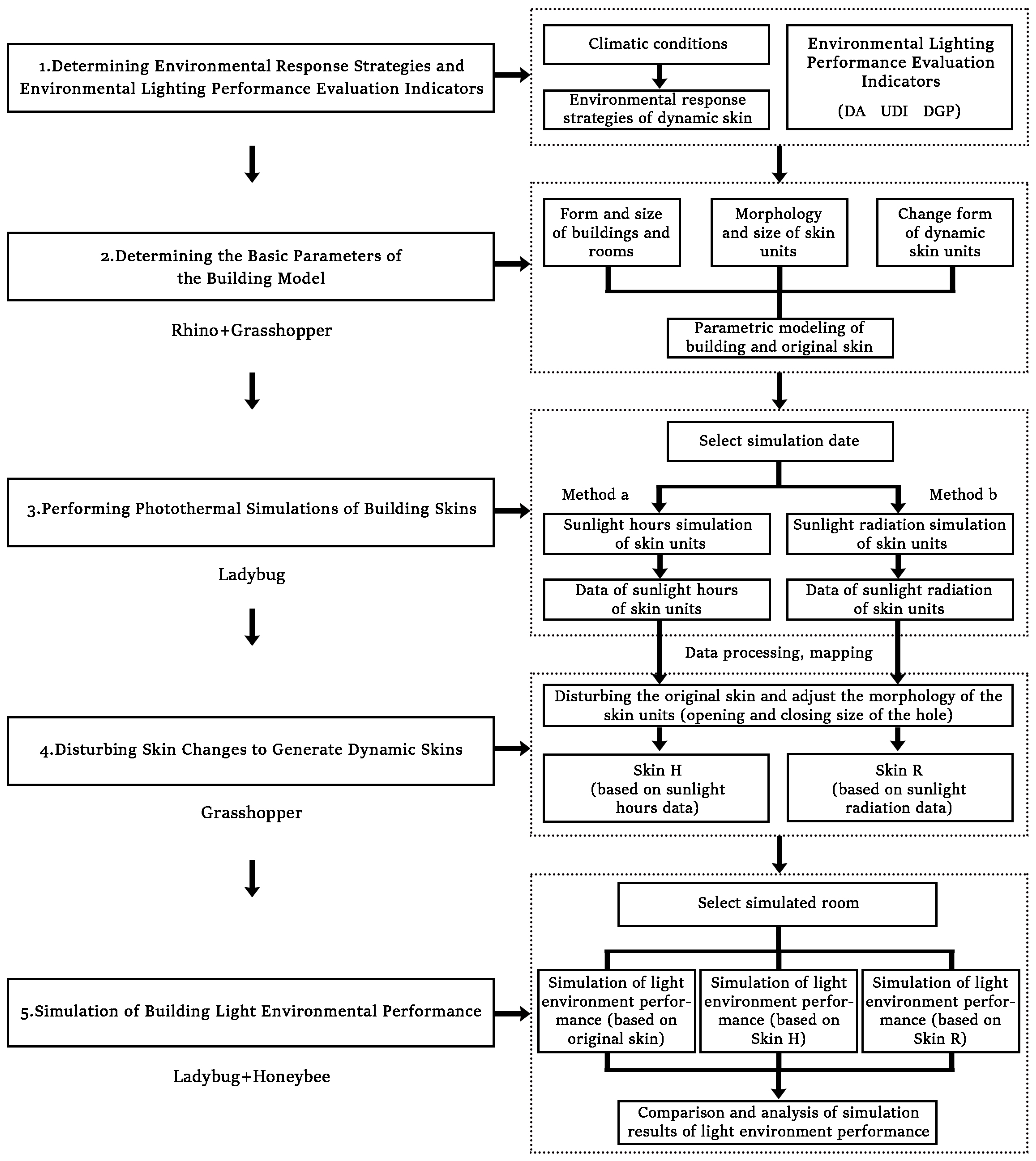





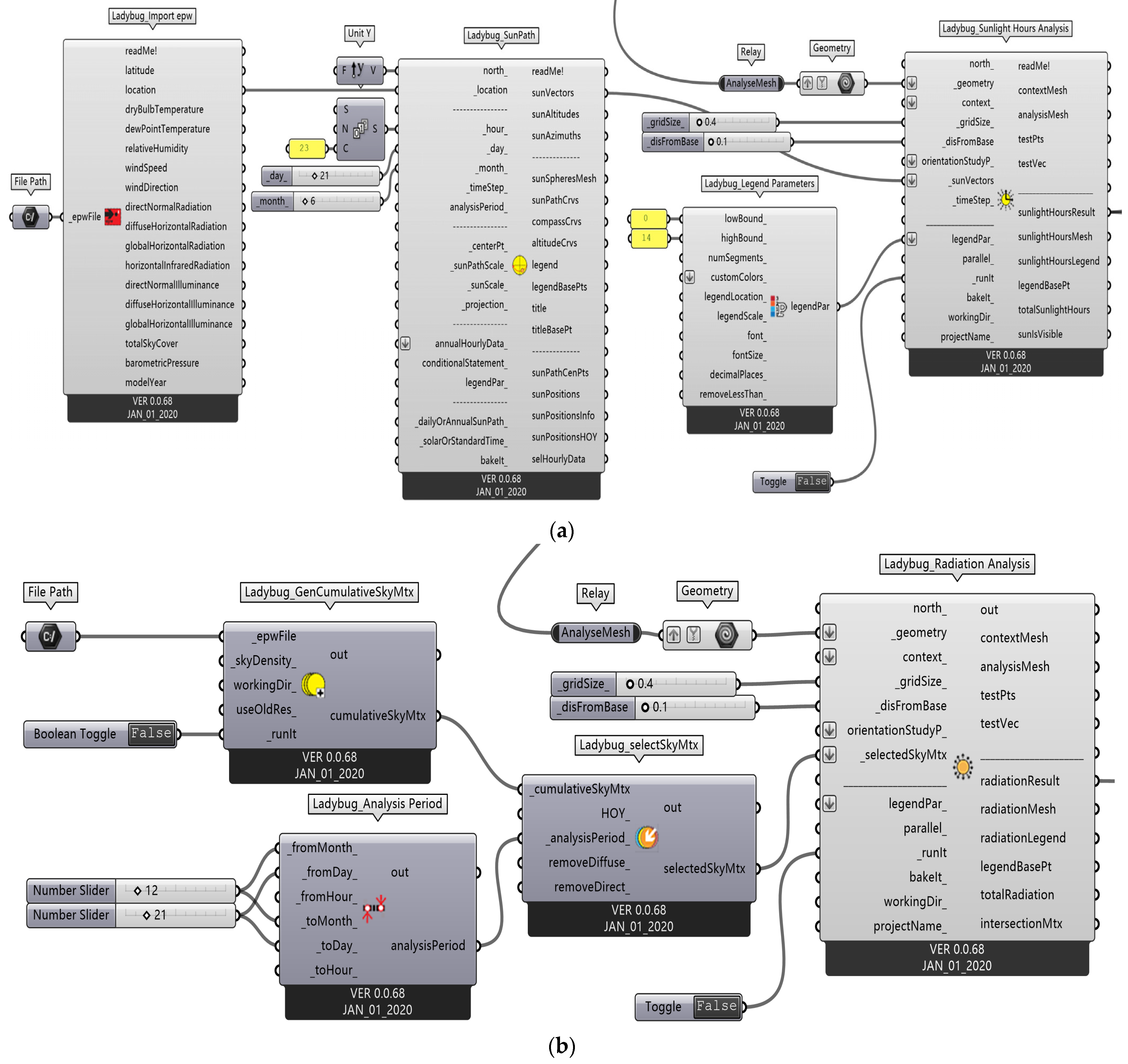

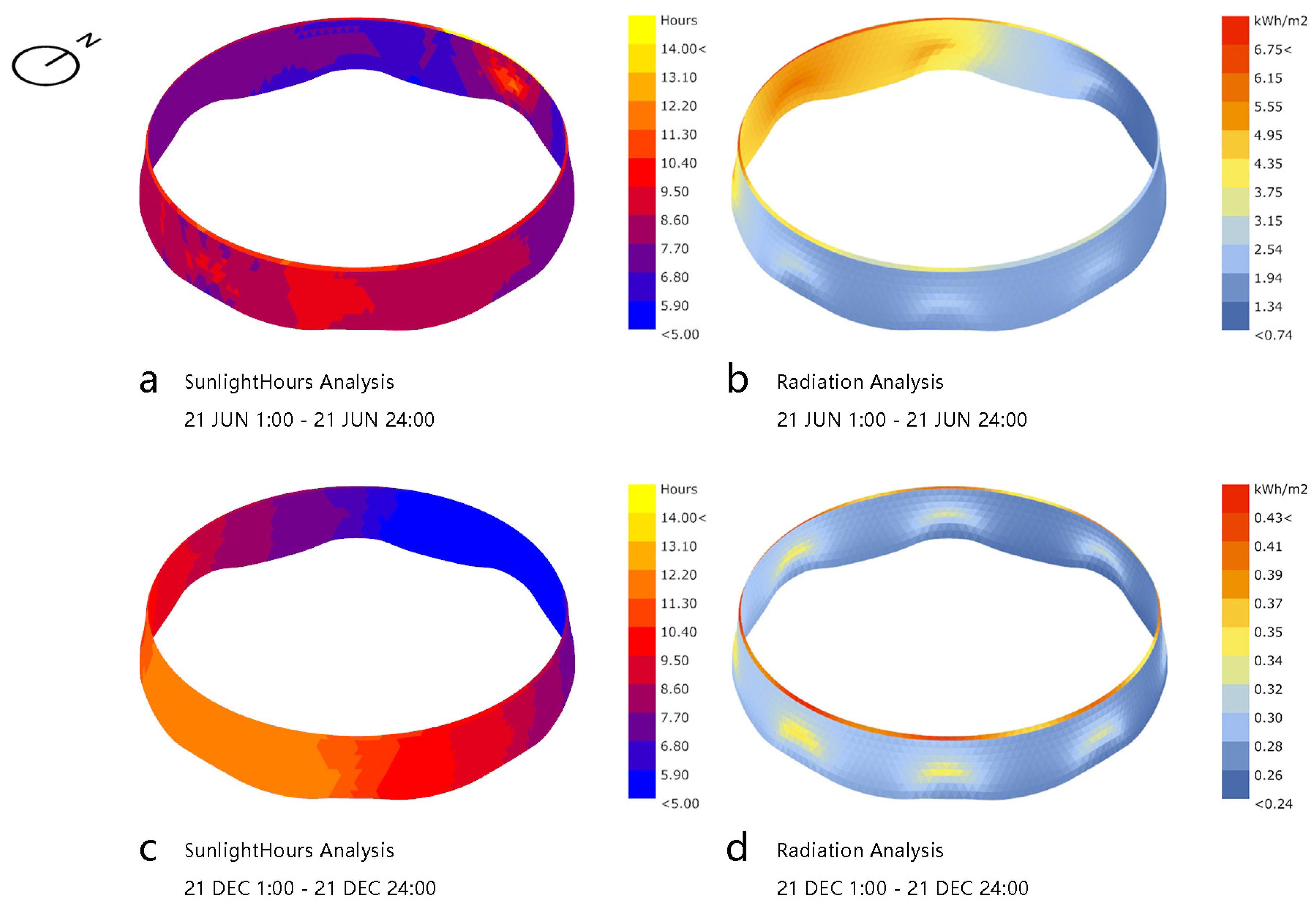



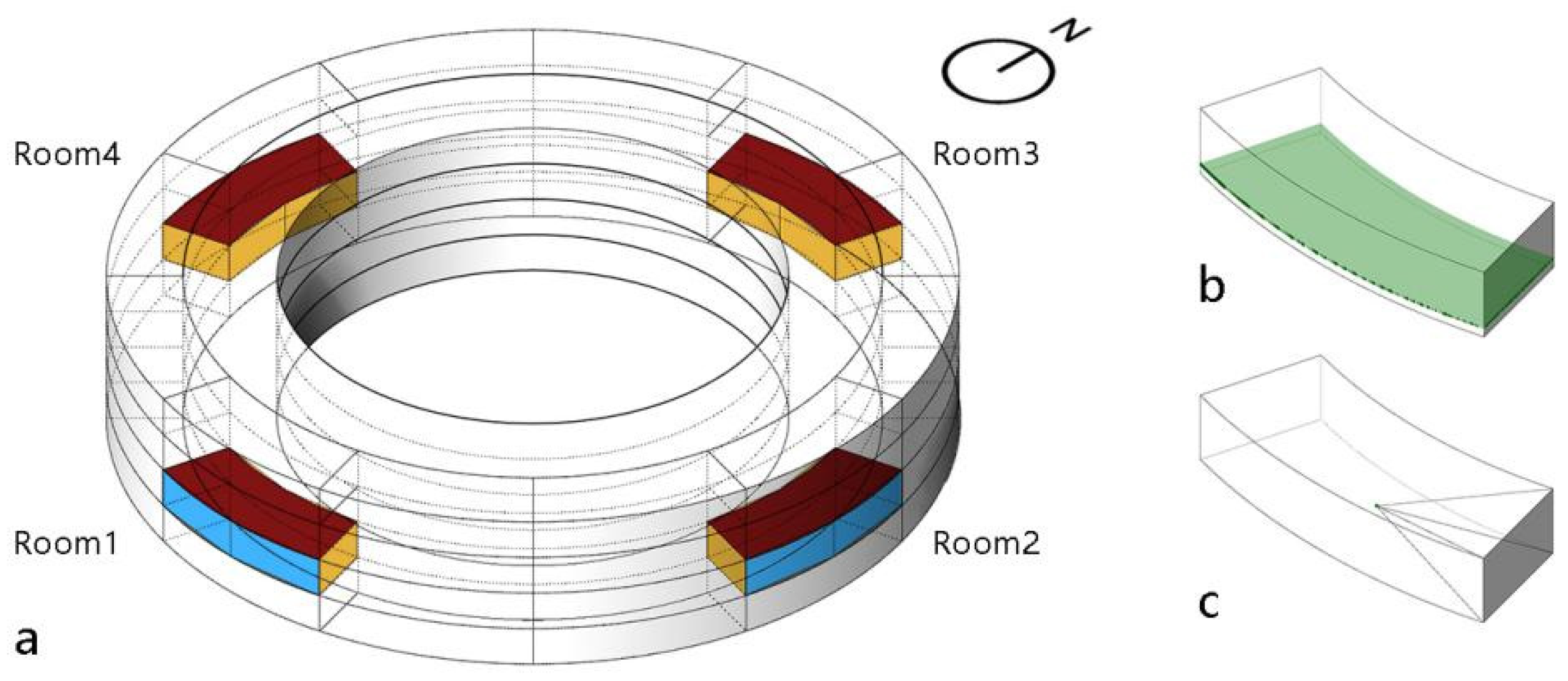
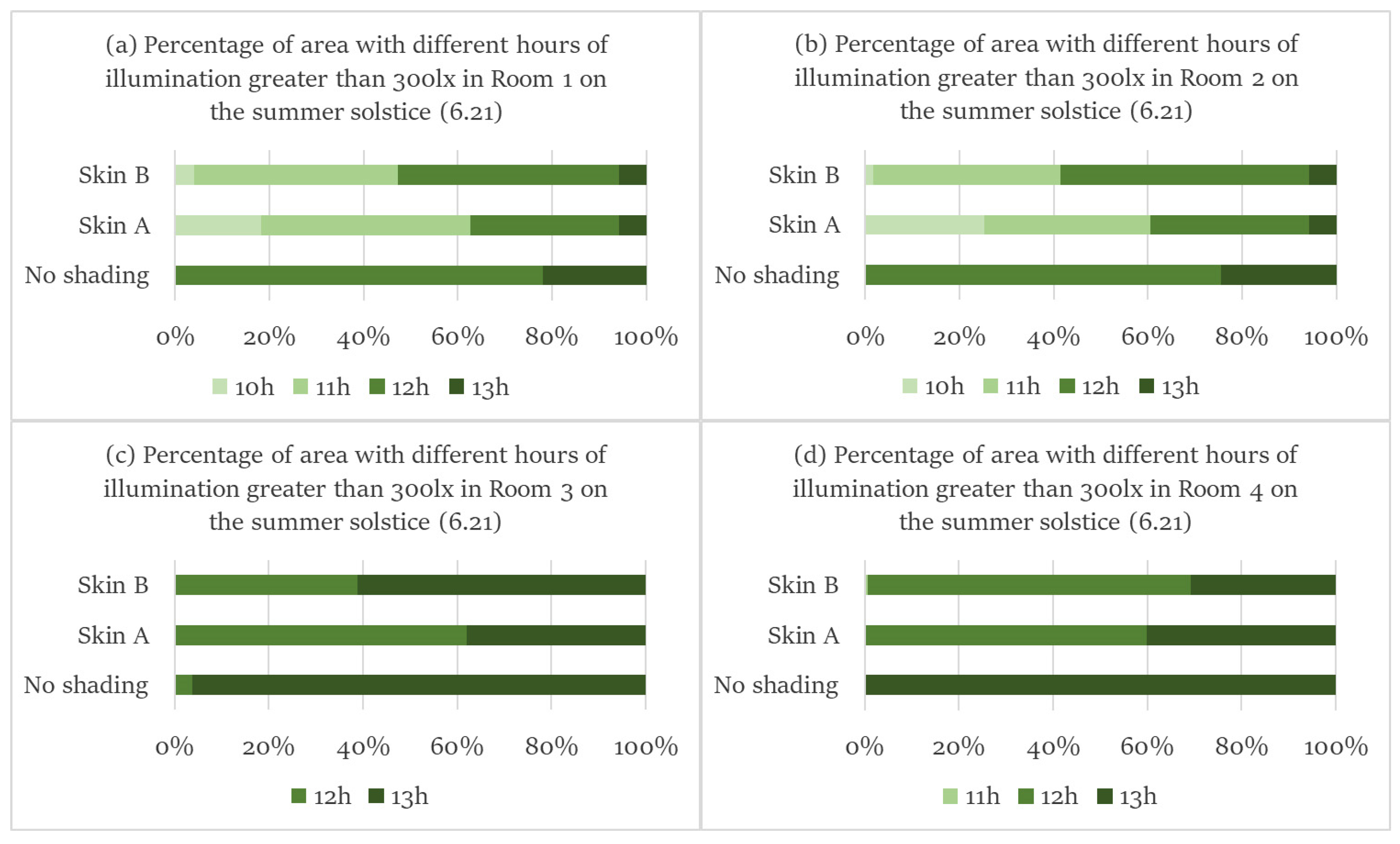

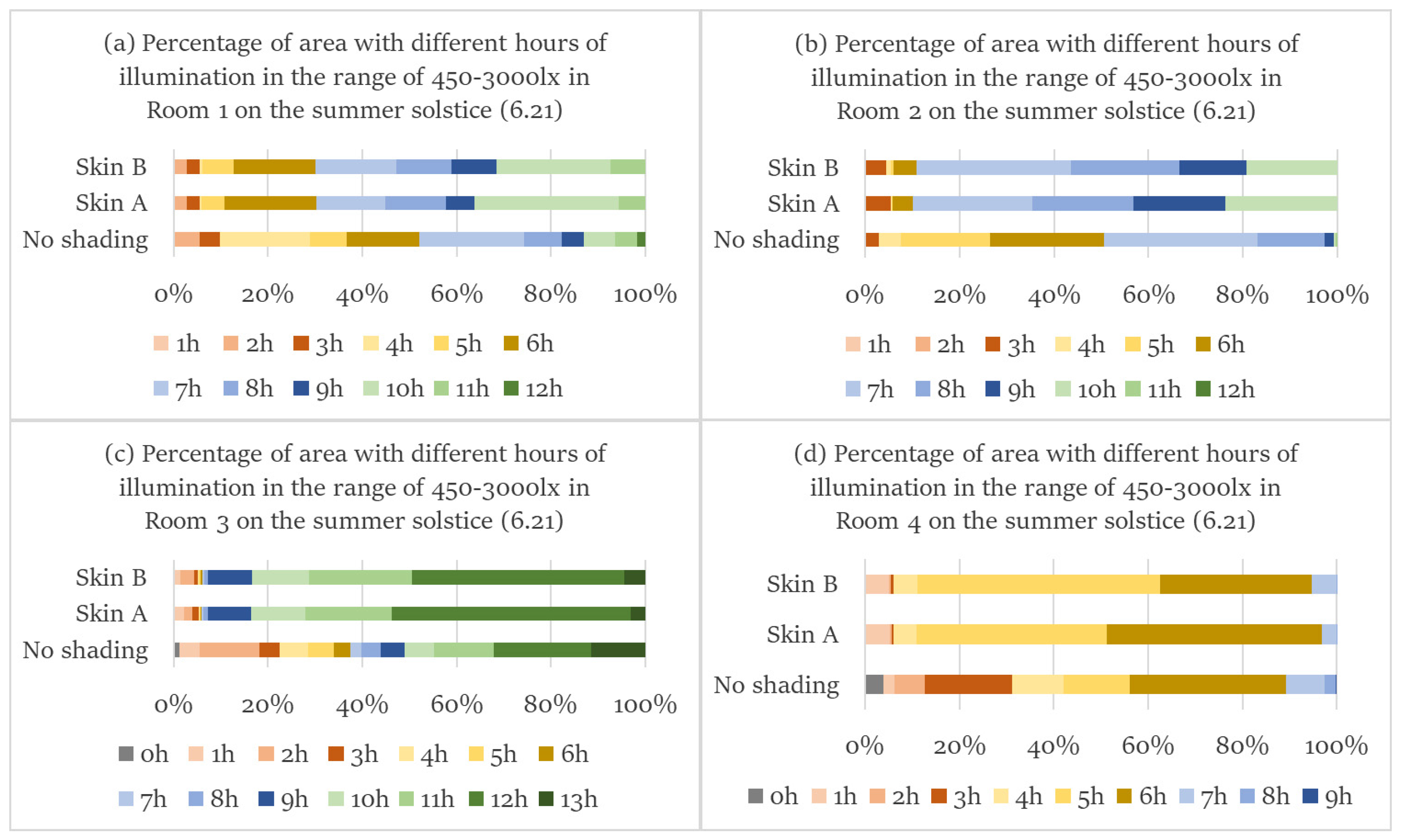
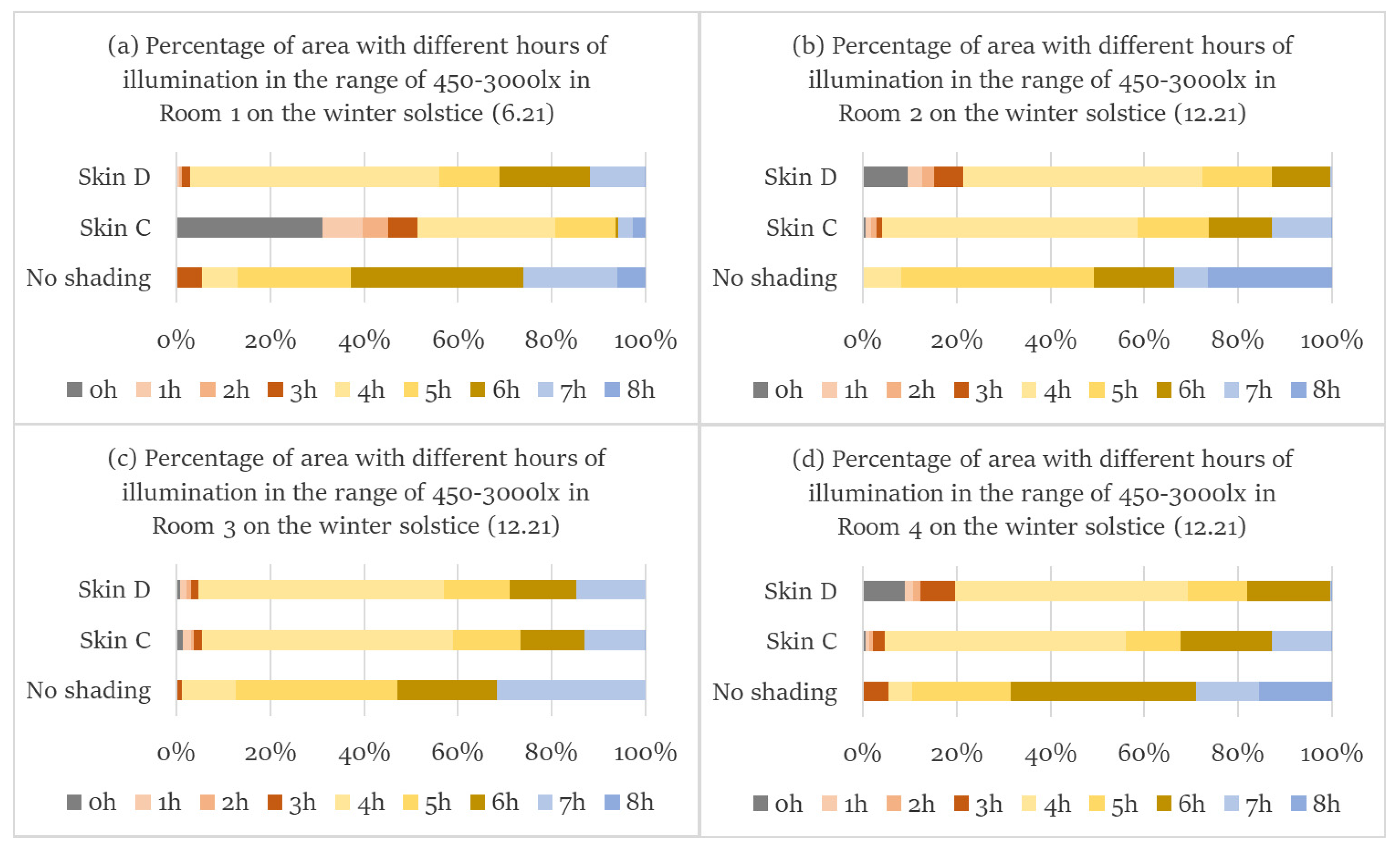

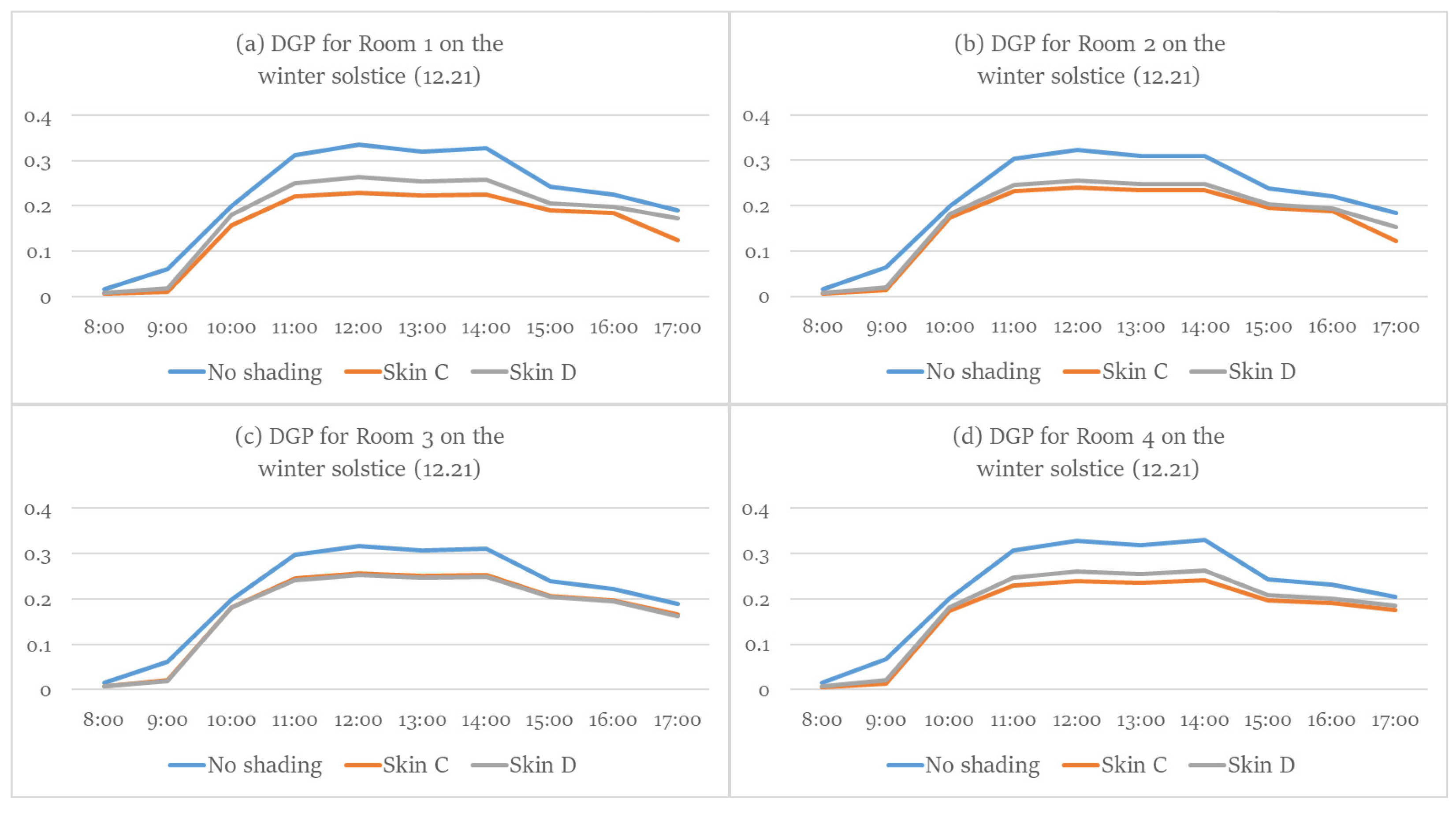
| Author/Year | Building Type | Façade | Variable Parameter | Platform | Optimization Objective | Method |
|---|---|---|---|---|---|---|
| Mahmoud AHA, et al./2016 [25] | Office building | Dynamic façade (kinetic façades) | Rotation motion, translation motion | Grasshopper + DIVA | Daylight | Parametric modeling, simulation |
| Hosseini S M, et al./2020 [26] | Traditional building | Dynamic façade | Window glass color, interior space partitions | Grasshopper + DIVA | Daylight | Parametric modeling, simulation |
| Lin C H, et al./2022 [27] | Office building | Fixed façade | Aperture, aperture change rate, number of attraction points, random seed of attraction point positions, and panel thickness | Grasshopper + DIVA Expert systems | Daylight | Parametric modeling, machine learning, artificial neural network |
| Yi Y K, et al./2019 [29] | Apartment | Fixed façade | Surface shape and amplitude, number of holes and size | Grasshopper | Daylight, aesthetic sensibilities | Parametric modeling, multiobjective optimization |
| Nadiri P, et al./2019 [36] | Office building | Fixed façade | The number, depth, angle, and thickness of south façade louvers | Grasshopper (Ladybug + Honeybee + Galapagos) | Annual sun exposure, view to outside | Parametric modeling, simulation, optimization |
| Chi D A, et al./2021 [37] | Office building | Fixed façade (perforated solar screens) | Orientations, perforation percentage, matrix, shape | Grasshopper + DIVA + Energy Plus | Daylight, thermal analysis | Parametric modeling, simulation |
| Anzaniyan E, Chi D A, et al./2022 [38] | Office building | Dynamic façade (biokinetic façade) | Panel angle | Grasshopper (Ladybug + Honeybee) | Daylight, energy | Parametric modeling, simulation |
| Bande L, et al./2022 [39] | Campus library | Dynamic façade | Folding mode | REVIT + Grasshopper (Ladybug, Honeybee, and Daysim) | Daylight energy | Parametric modeling, simulation |
| Chi D A, et al./2017 [40] | Office building | Fixed façade (perforated solar screens) | Perforation percentage, matrix, shape | DIVA/Grasshopper/Archsim + EnergyPlus | Daylight energy | Parametric modeling, orthogonal, array simulation |
| Season | Environmental Response Strategies |
|---|---|
| Summer | Avoid excessive heat and light in the room, focus on shade and protection from the sun, and prevent glare |
| Winter | Combines shading and heat storage to prevent glare |
| Spring & Autumn | Focus on shade and sun protection to prevent glare |
| Indicator | Unit | Comfort Range |
|---|---|---|
| Daylight autonomy (DA) | % | DA_300l× ≥ 50% |
| Useful daylight illuminance (UDI) | % | UDI (450~3000l×): an acceptable level of daylight |
| Daylight glare probability (DGP) | % | DGP ≤ 0.35: undetectable glare |
| Reflectance | Specularity | Roughness | Transmittance | Diffuse Reflectance | Diffuse Transmittance | |
|---|---|---|---|---|---|---|
| Ceiling | 0.75 | 0 | 0.05 | - | - | - |
| Floor | 0.58 | 0 | 0.05 | - | - | - |
| Wall | 0.75 | 0 | 0.05 | - | - | - |
| Glass (Low-E 6 + 12A + 6c) | - | - | - | 0.68 | - | - |
| Shade (PTFE) | - | - | 0.05 | - | 0.01 | 0.4 |
| The Percentage of the Area of the Room with Different Hours of Luminance Greater than 300l× | The Percentage of the Area with Different Hours of Useful Daylight Luminance | DGP | ||||
|---|---|---|---|---|---|---|
| Summer Solstice | Winter Solstice | Summer Solstice | Winter Solstice | Summer Solstice | Winter Solstice | |
| South | Sunlight radiation | Sunlight radiation | Sunlight hours | Sunlight radiation | Sunlight hours | Sunlight hours |
| East | Sunlight radiation | Sunlight hours | Sunlight hours | Sunlight hours | Sunlight hours | Sunlight hours |
| North | Sunlight radiation | Sunlight Radiation | Sunlight hours | Sunlight radiation | Sunlight hours | Sunlight Radiation |
| West | Sunlight hours | Sunlight hours | Sunlight hours | Sunlight hours | Sunlight radiation | Sunlight hours |
Disclaimer/Publisher’s Note: The statements, opinions and data contained in all publications are solely those of the individual author(s) and contributor(s) and not of MDPI and/or the editor(s). MDPI and/or the editor(s) disclaim responsibility for any injury to people or property resulting from any ideas, methods, instructions or products referred to in the content. |
© 2023 by the authors. Licensee MDPI, Basel, Switzerland. This article is an open access article distributed under the terms and conditions of the Creative Commons Attribution (CC BY) license (https://creativecommons.org/licenses/by/4.0/).
Share and Cite
Liu, Q.; Han, X.; Yan, Y.; Ren, J. A Parametric Design Method for the Lighting Environment of a Library Building Based on Building Performance Evaluation. Energies 2023, 16, 832. https://doi.org/10.3390/en16020832
Liu Q, Han X, Yan Y, Ren J. A Parametric Design Method for the Lighting Environment of a Library Building Based on Building Performance Evaluation. Energies. 2023; 16(2):832. https://doi.org/10.3390/en16020832
Chicago/Turabian StyleLiu, Qibo, Xiao Han, Yuheng Yan, and Juan Ren. 2023. "A Parametric Design Method for the Lighting Environment of a Library Building Based on Building Performance Evaluation" Energies 16, no. 2: 832. https://doi.org/10.3390/en16020832
APA StyleLiu, Q., Han, X., Yan, Y., & Ren, J. (2023). A Parametric Design Method for the Lighting Environment of a Library Building Based on Building Performance Evaluation. Energies, 16(2), 832. https://doi.org/10.3390/en16020832







